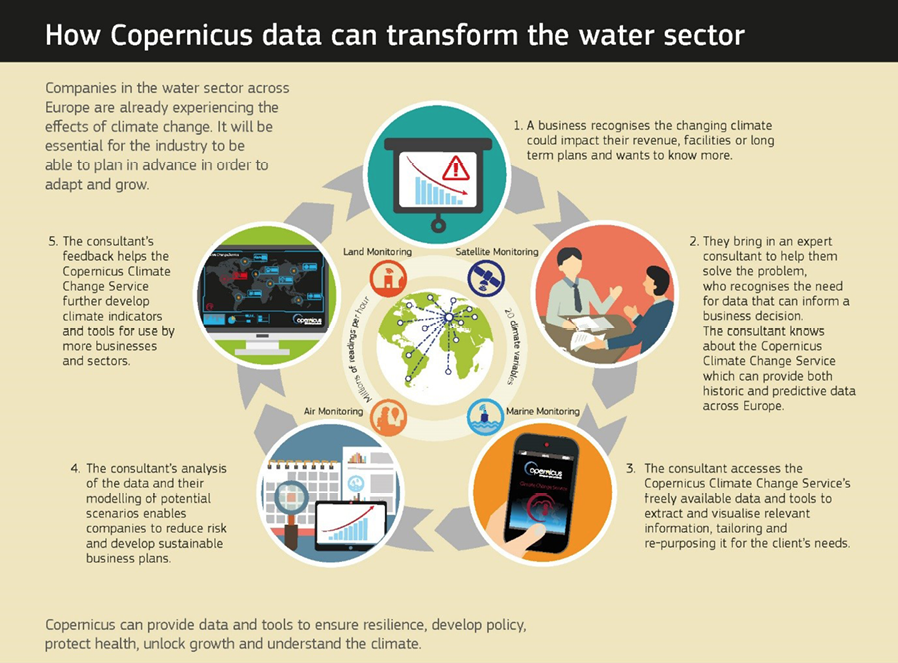As part of the implementation of the EU-funded Copernicus Climate Change Service (C3S), ECMWF aims to develop Sectoral Information Systems (SIS), which will provide sector-specific shop windows for the C3S Climate Data Store. Several SIS proof-of-concept projects are now under way. They will serve to develop tools and products which will be tested directly with users from sectors to which climate information is particularly relevant.
Copernicus at ECMWF
C3S is being implemented by ECMWF on behalf of the European Commission. It is part of the EU’s flagship Copernicus Earth observation programme, which delivers freely accessible environmental information services. ECMWF has also been entrusted with operating the Copernicus Atmosphere Monitoring Service (CAMS), which provides daily forecasts of atmospheric composition from the ground up to the stratosphere, and it contributes to the Copernicus Emergency Management Service (Copernicus EMS), which provides information relevant to the management of natural disasters, human-made emergency situations, and humanitarian crises.

From these proof-of-concept projects, and based on interactions with users, C3S will select a set of tailored sectoral climate indicators to be routinely produced and visualised. It will support the tools and promote best practices so that these sectors can take advantage of C3S climate information to enhance their businesses.
There are seven proof-of-concept projects, focusing on water (2); energy (2); insurance; agriculture; and infrastructure & health.
Each proof-of-concept is run by a consortium of organisations that bring sector-specific expertise to the projects. The primary partners working with ECMWF under the auspices of the European Union’s Copernicus Earth observation programme are:
- The Swedish Meteorological and Hydrological Institute (SMHI) for the Service for Water Indicators in Climate Change Adaption (SWICCA) project (Water) and the UrbanSIS project (Infrastructure & Health)
- The University of East Anglia for the European Climatic Energy Mixes (ECEM) project (Energy)
- Telespazio for the Agriclass project (Agriculture)
- CGI for the Wind Storm Climate Service (WISC) project (Insurance)
- The Centre for Ecology and Hydrology (CEH) for the End-to-end Demonstrator for Improved Decision Making in the Water Sector in Europe (EDgE) project (Water)
- Le Laboratoire des Sciences du Climat et de l'Environnement (LSCE) for the Clim4energy project (Energy).
Spotlight on water
Water and climate change are inextricably linked. Increases in temperature, shifts in precipitation patterns and snow cover and a likely increase in the frequency of flooding and droughts all pose challenges for the water management sector. C3S aims to help the water industry and policymakers tackle these challenges. Changes in Europe’s water resources will also have consequences for several other sectors, particularly agriculture, forestry, energy and health.
In recognition of this, two water–related contracts have been concluded as part of the SIS work.
- The Service for Water Indicators in Climate Change Adaption (SWICCA)
- The End-to-end Demonstrator for Improved Decision Making in the Water Sector in Europe (EDgE)
SWICCA
The SWICCA proof-of-concept project aims to:
- Advance the functionality and content of C3S to meet the needs of the water management sector
- Provide pan-European climate impact indicators based on the most relevant variables and indices for water management across Europe
- Gather a European community of consultants or ‘purveyors’ to the water sector to ensure that there is uptake of C3S through appropriate design and useful content.
SWICCA puts a strong emphasis on consultants or ‘purveyors’. These people are a crucial part of the SWICCA ‘ecosystem’, advising water managers and policymakers on all areas of water-related business and decision-making. They have the tools to translate, transform and visualise data and merge it with local information to create practical products for their clients. SWICCA will reach out to these intermediaries and form a community that will guide the development, design and use of the proof-of-concept project.
EDgE
EDgE will bring together a group of water management practitioners, hydrological experts and environmental information analysts qualified to define and develop climate impact indicators that will be of operational value to the water sector in Europe.
Using modelling – for both climate and hydrological impact – EDgE will produce terrestrial Essential Climate Variables (tECVs) specific to the water sector for past, current and future time horizons. In so doing it will contribute to the efforts of Climate-ADAPT and the WMO Global Framework for Climate Services (GFCS), among others.
EDgE will also deliver new Sectoral Climate Impact Indicators (SCIIs) co-designed with users from the European water sector community. The project will involve users in the UK, Norway and Spain, bringing them together in phases:
- Phase 1: Design, to establish current users’ requirements, decision contexts and practices, and to provide an assessment of candidate SCIIs and the SIS prototype and recommend specification for new products and SIS services
- Phase 2: Testing, to assess the proposed SCIIs and stage 2 Demonstrator prototype, and to refine the Demonstrator functionalities and make recommendations on language and accessibility
- Phase 3: Implementation, to review the final Demonstrator prototype and user guidance and to make final recommendations.
The project team itself includes representatives from regulatory institutions at European and national levels, government departments and policymakers, regional and local authorities, science and industry.
More information on the C3S Sectoral Information System proof-of-concept projects is available on the C3S website:http://climate.copernicus.eu/resources/information-service


